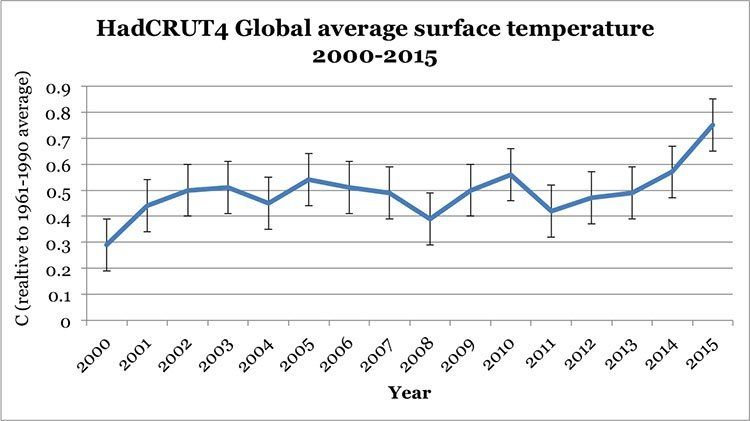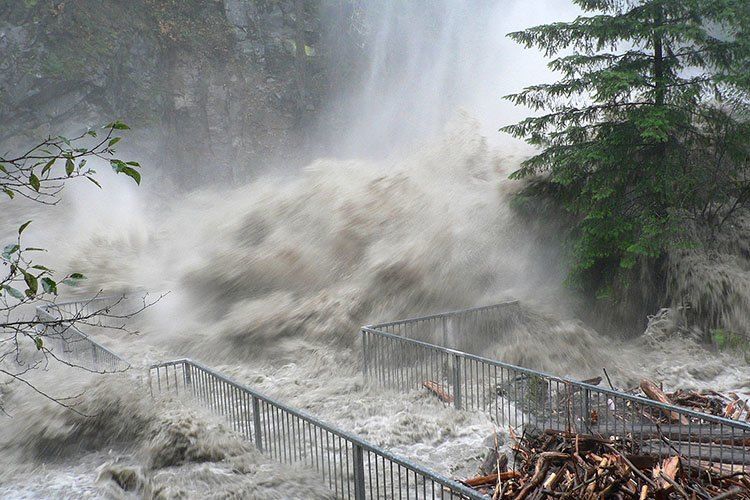

But the situation is very clear this year, says Prof. Tim Osborn from the University of East Anglia. He tells Carbon Brief:
“The HadCRUT4 global temperature record includes the most complete representation available of the various sources of error. Taking these into account, we can confidently say that 2015 was the warmest.”
HadCRUT4 is the longest of the three major global time series, extending back to 1850. It is jointly put together by the Met Office and the Climatic Research Unit at the University of East Anglia.
The graph below shows global temperatures and associated uncertainty ranges in HadCRUT4 since 2000. You can see the difference between the middle estimates for 2015 and the next warmest year in 2014 is a full 0.18C—over and above the typical uncertainty of 0.1C.
The only way that 2015 might not be the warmest year on record is if turned out the actual temperature was at the very bottom of the uncertainty range while the temperature for 2014 was at the very top. But the chances of that are extremely small, Osborn tells Carbon Brief:
“The slight overlap between the 2015 and 2014 ranges does not undermine our confidence that 2015 is the warmest year on record. For 2014 to be warmest, that would require the combination of two very unlikely events: 2014 to be at the very top of its confidence interval at the same time as 2015 being at the very bottom of its confidence interval.”
Dr. Thomas Karl, director of NOAA’s National Climatic Data Center, echoed this point, telling a press conference earlier today that it is “virtually certain” that 2015 is the hottest year on record. But while interest in which years break records is inevitable, understanding climate change means taking a much wider view. Osborn explains:
“It is the long-term trend that tells us about climate change, rather than the relative warmth of individual years.”
Q&A: A Boost From El Niño
As well as being a symptom of the long term warming trend, scientists are interested in 2015 global temperature because of what it tells us about how natural fluctuations in the climate can act to amplify or dampen the warming signal, Osborn explains.
A huge El Niño in the Pacific—among the biggest on record—contributed to the record warmth in 2015, say scientists. In total, 10 out of the 12 months in 2015 either tied with or broke previous records, according to NASA and NOAA’s joint analysis. Since the El Niño only recently reached peak strength, scientists expect its impact to be even larger in 2016.
Carbon Brief asked Prof. Adam Scaife, head of long-range forecasting at the Met Office, a few questions about the role of El Niño in the current spell of record-topping warmth.
How Do Scientists Work Out the Impact of El Niño on Global Temperature?
Using the historical observational record, which now extends back more than a century and theoretical computer models, which have been used to simulate even longer periods, we are able to calculate what happens to global temperature in the run up to an El Niño (or La Niña) and in its aftermath. The effects are very clear: there is a little warming in the period preceding the winter El Niño peak, but the big effect on global temperature comes in the following calendar year as it takes a few months for heat to increase in other ocean basins around the world. The bottom line is that for each 1 degree of El Niño the global temperature in the following year rises by about 0.1 degrees.
How Much of the Record Temperature in 2015 Was Down to El Niño?
El Niño was growing in 2015 and only reached its peak this winter. So, we think El Niño made only a small contribution (a few hundredths of a degree) to the record global temperatures in 2015.
Does that mean human activity was the biggest driver of 2015’s record temperature?
Yes. The nominal record global average temperature of 2015 was well predicted in advance and well explained as being primarily due to global warming, itself mainly due to greenhouse gas emissions of human origin. El Niño made only a small contribution.
What Can We Expect in 2016?
Given the strength of the current El Niño, we expect 2016 to be even warmer globally than 2015. The lagged effects of El Niño are already starting to appear in the monthly temperature observations which are registering more than 0.8 degrees above norm in recent months. This is consistent with our forecast for unprecedented warmth in the coming year. Overall, we expect El Niño to contribute around 25 percent to what will most likely be a new record global temperature in 2016. Much of the rest is down to climate change.
YOU MIGHT ALSO LIKE
There Will Be More Plastic Than Fish in the Ocean by 2050
Leonardo DiCaprio: ‘Enough Is Enough’ Corporate Greed Must Stop
Heat Absorbed by Oceans Has Doubled Since 1997
Bill McKibben: How to Stop the Fossil Fuel Industry From Wrecking Our World

 233k
233k  41k
41k  Subscribe
Subscribe 

